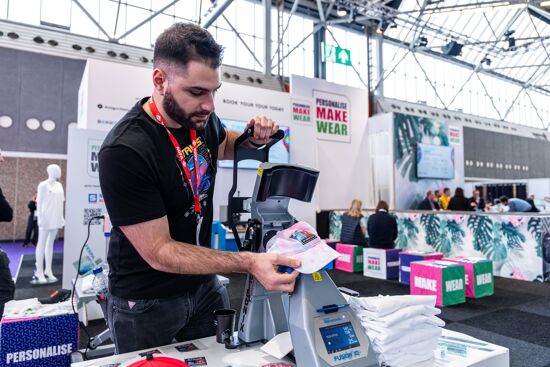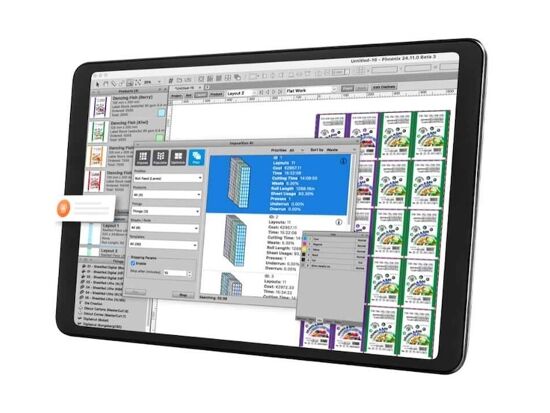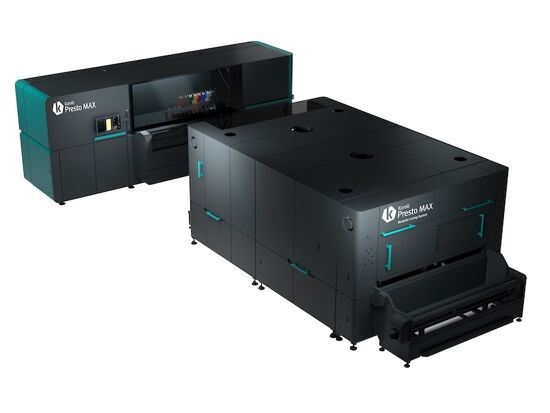What does Artificial Intelligence mean for the Design and Print Industry

Today, Artificial intelligence is already built into many products even though at times it is not noticeable. Looking towards the future, the growing presence of AI will change the design and printing industry forever. Sonja Angerer shares how you can successfully future-proof your business.
Today, Artificial Intelligence (AI) is a popular topic of conversation regardless of the industry sector. The “Big 5”, i.e. Amazon, Apple, Google, Meta, and Microsoft, are investing substantial capital in this new technology. It is evident that it will change how we all work. But for most professions, it will take some time for AI to really become prevalent and impactful.
In recent years, the job description of a graphic designer has already changed massively. Nevertheless, it is quite possible that designers are among the first professional groups to be impacted by AI. In turn, AI will inevitably also affect the printing industry.
 CAPTION: Artificial intelligence can manage creative tasks such as creating patterns. Image credit: Microsoft Co-Pilot, Prompt: S. Angerer
CAPTION: Artificial intelligence can manage creative tasks such as creating patterns. Image credit: Microsoft Co-Pilot, Prompt: S. Angerer
What is AI and why is it changing the design industry?
AI is the ability of machines to replicate human intelligence. This means that programs are not just processed step by step. The algorithm can recognise patterns and can therefore learn from experience.
Today, artificial intelligence is designed to excel in specific areas, e.g. image creation. In the past, AI was only used by scientists and highly skilled professionals. However, today all professions can use Microsoft Copilot or Google Gemini. All you need is an internet-enabled device. Adobe Firefly is also currently available to anyone who wants to using "prompts". "Prompts" are detailed instructions provided to the AI to complete tasks.
AI currently creates illustrations and stock photos effectively. Although, you need a bit of practice when creating effective prompts. The resulting images are usually only in web resolution. This means that you can't use them for printing. Nevertheless, it is predicted already that it will soon no longer be possible to earn money with simple infographics or stock photography. As a result, many advertising agencies will lose a high-turnover business segment in just a few years. The same is true for printers with dedicated arts departments.
 CAPTION: AI can already generate appealing stock photography when the right prompt is used. Image credit: Adobe Firefly, Prompt: Sonja Angerer
CAPTION: AI can already generate appealing stock photography when the right prompt is used. Image credit: Adobe Firefly, Prompt: Sonja Angerer
How AI will change print jobs in the future
AI is still mainly used for images in the creative industry. However, free design apps have also been on the market for a few years now. Examples of such apps are Adobe Express, Canva or Visme. By using these apps, one can create simple layouts with almost no prior knowledge or expertise. Therefore, it is likely that many clients will have smaller budgets for creative services in the future. They may also delegate assignments to less qualified staff.
For print shops and full-service providers, this has critical consequences:
-
The quality of customer print-ready data continues to decline.
-
Professionals are leaving the design industry.
-
The back-up of customer data is becoming more complex.
At the same time, artificial intelligence can improve processes in the digital printing industry. AI software is already available for printers to take advantage of. Artificial intelligence simplifies production planning and searches company data for hidden trends and tendencies and manages many other tasks.
 CAPTION: Prompt and generated selection image, created with Microsoft Co-Pilot / Bing on an Android smartphone. Prompt: S. Angerer
CAPTION: Prompt and generated selection image, created with Microsoft Co-Pilot / Bing on an Android smartphone. Prompt: S. Angerer
How can printers adapt to AI in the design industry?
All print shops should prepare for the fact that artificial intelligence will change the creative industry because they will experience the effects.
Many printers are currently working on metaverses. These are 3D worlds where people can spend their free time where they usually wear virtual reality glasses. In the metaverse, they can meet friends, play and shop.
“The metaverse has the potential to fundamentally change the way people and companies interact with each other. This development is not in the future, it has already begun. For companies, this innovative environment not only offers the opportunity to open new business areas, but also the chance to present and strengthen existing activities in a digital guide,” says Prof. Dr. Eric Wagner, resident partner in the Metaverse office of Gleiss Lutz.
Currently, metaverses are not available to everyone. However, young target groups have already expressed their interested in virtual worlds. Therefore, additional advertising budgets are likely to be reallocated in the future.
Therefore, it is particularly important for printers to continue to expand their consulting expertise and take advantage of this opportunity in AI. They also need to work on establishing print products as the best solution for communication. Artificial intelligence can also help with this. After all, AI already offers exciting tools not only for designers, but also for marketing specialists.
Topics
Interested in joining our community?
Enquire today about joining your local FESPA Association or FESPA Direct
Recent news

Special Effects in DTF Will Make Your “Prints” More Memorable
The DTF market is expanding with new vendors and innovations like multi-head printers enabling diverse ink options (spot, neon). Decorative films offer streamlined special effects. Keypoint Intelligence tested metallic and glitter films, noting varied ease of use and wash durability. New technology using adhesive and foil directly promises further creative advancements in DTF.

SmartHub – Expectations, opportunities and why you should attend!
The SmartHub at Personalisation Experience 2025 in Berlin will showcase personalisation and smart production opportunities across industries like textiles. Featuring a Smart Factory Trail with brands like Inkcups and Trotec, and a conference with experts discussing AI, mass customisation, and profit strategies, it offers insights into reducing waste and boosting efficiency through digital methods. Panel sessions will explore growth, automation in textiles, and smart manufacturing.

How is AI revolutionising Large Format Print?
Nessan Clearly discusses how AI in print relies on data pattern matching, already enhancing software for large format providers. He predicts that this will result in increased AI integration in workflow planning, job queue management, colour correction, image upscaling, and predictive maintenance via sensors and vision systems, ultimately streamlining operations and offering greater flexibility.

One Ink for All? Exploring Pigment in Textile Printing
Digital textile printing faces complexity due to diverse substrates requiring specific inks. The industry seeks a universal ink, with pigment ink showing potential. While traditionally for natural fibres, advancements aim to broaden its application, simplify processes by reducing pre/post-treatment, and improve sustainability, though challenges like hand feel on garments remain.